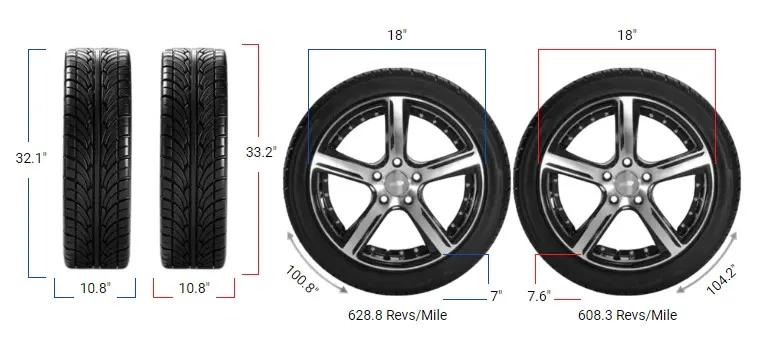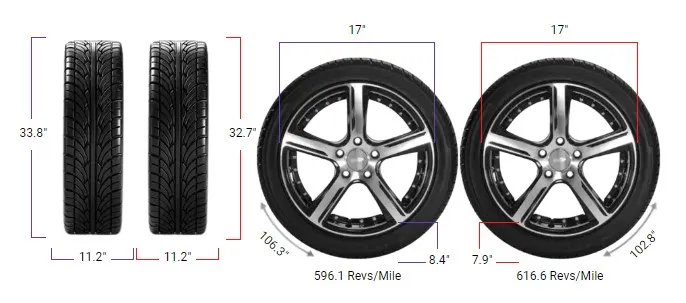Tire Size 235/40r18 vs 235/45r18

Swapping out your tires can be a big decision, with implications for both on-road performance and off-road capability. We’ll dive into the details of switching from a 235/40R18 to a 235/45R18 tire, exploring the key differences and their real-world impacts.
- Greater sidewall height for improved ride comfort
- Reduced revolutions per mile for potentially better fuel economy
- Speedometer will read slightly lower than actual speed
- Increased ground clearance by about 0.46 inches
- Potentially improved traction due to larger contact patch
- May affect handling characteristics slightly
- Ensure proper fitment for your vehicle before switching

Fitment Guide
According to the data provided, the diameter difference between these two tire sizes is 0.93 inches (23.5 mm), which represents a 3.6% increase.
This falls within the recommended 3% range, meaning the 235/45R18 tire is a suitable replacement for the original 235/40R18 tire without requiring any major adaptations or modifications.
On-Road Impact
The increased sidewall height of the 235/45R18 tire can have a noticeable impact on the vehicle’s on-road performance.
This change may result in a slightly softer and more compliant ride quality, as the taller sidewall can help absorb more road imperfections and provide a more cushioned feel.
Additionally, the slight increase in overall tire diameter can slightly affect the speedometer accuracy, causing the speedometer to read approximately 0.73 mph (1.17 km/h) higher at a true speed of 20 mph (32.19 km/h).

Off-Road Impact
When it comes to off-road performance, the increased sidewall height of the 235/45R18 tire can provide a small but potentially beneficial boost in ground clearance.
This extra clearance may be helpful when navigating over obstacles or traversing uneven terrain. However, the overall impact on off-road performance is likely to be relatively minor, as the difference in tire size is relatively small.
235/40r18 vs 235/45r18 Table
Here’s a detailed comparison of the tire sizes 235/40R18 and 235/45R18 to help you understand the difference.
| Feature | 235/40R18 | 235/45R18 | Difference |
|---|---|---|---|
| Diameter inches (mm) | 25.4 (645.2) | 26.33 (668.7) | 0.93 (23.5) +3.6% |
| Width inches (mm) | 9.25 (235) | 9.25 (235) | 0 (0) 0% |
| Circumference inches (mm) | 79.8 (2026.96) | 82.71 (2100.78) | 2.91 (73.83) +3.6% |
| Sidewall Height inches (mm) | 3.7 (94) | 4.16 (105.75) | 0.46 (11.75) +12.5% |
| Revolutions per mile (km) | 793.97 (493.35) | 766.07 (476.01) | -27.9 (-17.34) -3.5% |
| Speedo Reading | 20 mph | 20.73 mph | +0.73 mph |
Can I Use 235/45R18 Instead of 235/40R18?
Yes, you can generally use a 235/45R18 tire as a replacement for a 235/40R18 tire. The 3.6% difference in diameter falls within the recommended 3% range, so the 235/45R18 is a suitable replacement without requiring any major adaptations or modifications.

How Much Taller Is a 235/40R18 Tire Than a 235/45R18?
The 235/45R18 tire is 0.46 inches (11.75 mm) taller than the 235/40R18 tire. This represents a 12.5% increase in sidewall height between the two tire sizes.
What is the Difference Between 235/40R18 and 235/45R18?
The most significant difference between these two tire sizes is the sidewall height. The 235/45R18 tire has a sidewall that is 0.46 inches (11.75 mm) taller than the 235/40R18 tire, which equates to a 12.5% increase in sidewall height.
Our Observation
The switch from a 235/40R18 to a 235/45R18 tire represents a relatively modest change in terms of both on-road and off-road performance.
The increase in sidewall height can provide a slightly more comfortable ride and a minor boost in ground clearance, while the speedometer inaccuracy is within a manageable range.
Overall, the differences are relatively small and may not significantly impact most drivers’ daily experiences, making this a reasonably straightforward tire upgrade that should not require any major adaptations or modifications to the vehicle.



